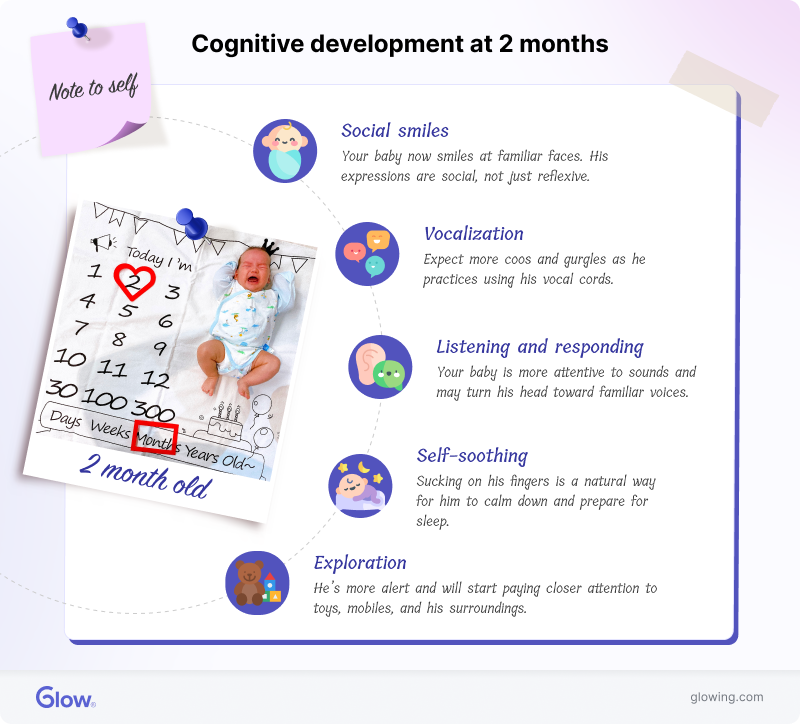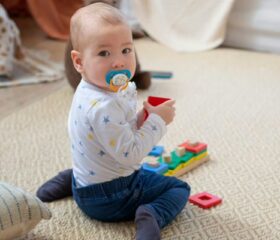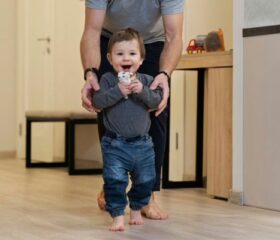Baby Month by Month
2-Month-Old Baby
Your baby’s movements are getting more coordinated and deliberate.

At two months, now’s the time when you can trade in a bit of your postpartum exhaustion for the excitement of watching your baby become more alert, interactive, and expressive. Read on to find out the ins and outs of connecting with your 2-month-old baby.
What to expect this month from your baby
Your baby’s more active than ever. He’s growing like a weed and is endlessly curious about his surroundings. Here’s a taste of what you can expect during his second month.
Physical development
Welcome to the wonderful world of baby fat. Here’s how your baby’s physical development is going this month:
- Growth: Your baby’s getting pretty plump, and will have tacked on about 4–5 pounds and 1–2 inches in length since his debut. This averages to about 11 pounds for girls and 12 pounds for boys. 1 For length, the averages hover around 22.5 inches for girls and 23 inches for boys. 2
- Improved vision: If you observe your baby’s eye movements, you’ll notice they’re a bit more coordinated, and he can now track moving objects. He’ll become a big fan of colors and high-contrast patterns.
- Hands to mouth: Your baby’s hand-to-mouth movements will become more deliberate this month. Consider it one of many signs of his developing self-awareness and a way to explore his body.
- Grasping: While your baby can’t hold on to anything for long, the setback certainly won’t stop him from trying. All this primitive grasping is great practice for some of the more refined grasping he’ll accomplish later in life, like your baby’s pincer grasp.
You can track your baby’s milestones in a baby tracker app. The best baby trackers also include general timelines for these milestones so that you can check in with your doctor if there’s an issue.
Tummy time
Tummy time refers to putting your baby on his stomach while he’s up and about. Doing this several times throughout the day for 3–5 minutes a session (15–30 minutes total daily) has a whole host of benefits for your little one, most of which have to do with developing his muscular control. 3
Tummy time will help your baby build his neck muscles, making lifting his head and chest easier in the future. You’ll also see him doing “mini-push-ups”—trying to push himself off the floor, which is his first move toward strengthening his forearms and eventually crawling.

Cognitive and social development
Watch your baby’s cuteness factor jump a few notches as he builds his cognitive and social skills:
- The social smile: If you’ve been waiting for your baby’s first smiles, here’s some good news. Gone are the days of your baby’s purely reflexive smiles. He’s developed enough to recognize familiar faces and respond to what people do, meaning you’ll finally see true “social smiles.”
- Vocalization: Expect an uptick in coos and gurgles as your baby flexes his vocal cords. While it’ll still be a while before your baby starts talking, this is all practice for communication. Feel free to talk back and help him learn.
- Listening and responding: Your baby is paying more attention to sounds, even turning his head in recognition of certain voices.
- Self-soothing: Hand and finger sucking is your baby’s natural way of self-soothing. From now on, he’ll do this a lot to calm himself and sometimes prepare for sleep.
- Exploration: As you may be gathering, your baby will generally be more alert this month than he was as a newborn. Watch as he soaks everything in and becomes more interested in his toys and mobiles.
Don’t worry if your baby doesn’t hit you with all of these traits at once. Give him the time he needs, and reach out to your pediatrician if you have any nagging concerns.
Feeding
At two months, your baby still isn’t on a strict schedule, but you’ll still notice more consistent patterns in his feeding and sleeping habits.
As for how much your baby needs to eat, expect to nurse around 7–9 times daily. If you plan to pump your breast milk, whether manually or electrically, do this according to a set routine. You can also store breast milk in the freezer for later. 4
If you feed him formula, know that babies drink about 4–5 ounces about 6–8 times a day. As with breastfeeding, respect when your baby signals that enough is enough.
Here’s what else you should know about feeding time:
- Practice responsive feeding: Following your little one’s hunger and fullness cues means watching for signs like rooting (an involuntary motor reflex at the corner of his mouth), sucking on his hands, or smacking his lips. Similarly, if he turns his head away, it’s a sign that he’s full.
- Don’t prop up the bottle: Don’t cut corners by propping your baby’s bottle up unattended on an object like a stand or blanket when feeding. Go the hands-on route for safety and enjoy a bit of bonding in the process.
- Safely store unused formula: If you made too much formula for your baby, you can safely store it in the fridge in a sealed container. Unused formula usually stays good for about 24 hours when refrigerated.
Sleep patterns
Your 2-month-old’s sleep schedule should be a bit easier to get to grips with now. He’s easily clocking in about 14–17 hours of sleep a day. 5
While he’s (thankfully) now out for longer stretches at night, he may still wake up frequently to eat, and it’ll still be a while before your baby starts sleeping through the night.
The time your baby is awake between naps and nighttime sleep is known as a “wake window.” While your baby’s wake windows increase with age, daytime naps remain a necessity at this stage. Consider laying him down for two naps in the morning, two in the afternoon, and a short one in the evening. As he gets older, he’ll nap less and sleep longer at night.
Encourage your baby’s sleep patterns with a calming environment, and put him to bed when he’s tired but awake.
Safe sleeping practices for your baby
As far as sleep safety goes, your baby should be a back-sleeper for the time being. Babies shouldn’t sleep on their stomachs until they’re at least 12 months old.
Use a crib with a firm mattress, and it’s usually fine to swaddle your baby at this age. But when your baby can roll over, you should stop swaddling him. 6
As much as you may want to make your baby comfy and cozy, never let him sleep with soft items that could be potential choking hazards.
For example, babies can’t sleep with a blanket until they’re at least a year old. For pillows, you’ll need to wait even longer. Your baby can’t sleep with a pillow until he’s around 2 years old.
Health and safety for month two
The two-month mark means it’s time to check a few boxes in the health and wellness department. Here’s everything you’ll need to do this month:
Well-baby visit
Mark the calendar for your baby’s two-month well-baby visit. In addition to the customary fawning, the folks at the pediatrician’s office will also record your baby’s weight, length, and head circumference.
Feel free to talk your pediatrician’s ear off about your baby’s development and voice any concerns or questions you have when it comes to his sleeping, feeding, or behavior.
Babies his age also often have to deal with minor (and treatable) skin issues like baby acne, different types of diaper rashes, eczema, and cradle cap, so bring up any changes in his skin that you want your pediatrician to take a closer look at.
Vaccinations and other immunizations
At two months old, your baby is now ripe to receive a round of vaccinations. These are important, as they’ll protect him against several severe illnesses.
Here are the vaccinations and other shots you can expect for the little one: 7
- DTaP vaccine: One of the most important vaccines for your little one is the DTaP, which shields your baby from diphtheria, tetanus, and pertussis (whooping cough).
- Hib vaccine: This vaccine guards against Haemophilus influenzae type b, which can cause bacterial meningitis, pneumonia, and throat swelling.
- Polio vaccine: This prevents polio’s viral attack against the spinal cord and brainstem.
- Pneumococcal vaccine: This protects against pneumococcal infections like meningitis and pneumonia.
- Rotavirus vaccine: This is an oral vaccine that stops the leading cause of infant diarrhea.
- Hepatitis B vaccine: Your baby may have already had the first dose of this protection against liver disease. If so, then this one will be the second of three shots.
- Respiratory syncytial virus (RSV) antibody: This shot, often recommended during RSV season (October to May), protects your little one against bronchiolitis and pneumonia. It’s technically an antibody rather than an actual vaccine, but it’s just as important. 8
Other safety tips for parents
Of course, your job isn’t limited to keeping your baby safe from diseases. His physical safety is just as important. Follow these tips to protect him from the biggest causes of injury in infants:
- Car safety: Keep your baby secure by properly installing his car seat. His seat should be reverse-facing, and you shouldn’t turn your baby’s car seat around until he’s at least 1 (though experts recommend a rear-facing position for as long as possible). Also, never leave him strapped in unattended, even for a few minutes.
- Home safety: An increasingly mobile infant means it’s extra important to baby-proof your home. This includes keeping small objects, chemicals, and electrical cords out of reach.
- Crib height: Adjust your baby’s crib mattress height as he develops. Keep it high for newborns and lower it when he becomes more mobile (meaning he’s in more danger of climbing out and falling).
- Pacifiers: Keep your baby’s pacifier clean and avoid attaching it to his crib or neck.
You should also make sure you have everything on hand that you need to keep him happy and comfortable. Don’t get caught without diapers, wipes, diaper cream, a changing pad, a burp cloth, and a change of clothes.
Unfortunately, this month is often when PURPLE crying (a period where your baby becomes extremely fussy and difficult to soothe) peaks. If your baby ever gets fussy, try a massage to calm his nerves. Rub him in circular motions with baby-safe oil or lotion, or just your hands.
Your post-pregnancy body at two months
Your body is still recovering from labor, so don’t expect to get back to your normal self straight away. While many aspects of the “former you” will spring back to normal relatively quickly, some things will take time to return (e.g., your first period after giving birth), and you may even have some permanent changes.
Some long-haul changes include slightly wider hips, darker and bigger nipples, and enlarged feet. Try not to get down about the changes to your body. When you get to see your little one smiling back at you, you’ll know they were all worth it. 9
Your post-pregnancy mental health at two months
Don’t beat yourself up if you felt down, irritable, or overwhelmed after giving birth. The baby blues is a common phenomenon that typically starts after childbirth and lasts for several weeks.
Many women also experience postpartum rage (intense anger, irritability, and overwhelming negativity during postpartum) as a result of the hormonal and lifestyle changes that come after pregnancy and giving birth.
If you’re still feeling down, hopeless, numb, or not connected to your little one at the 2-month mark, then it’s time to get some help from your doctor. When the baby blues stick around and the symptoms get worse, it’s called postpartum depression, which can last for months and even years if left untreated. 10
Take things easy and allow yourself to process your feelings. Talk to your partner, friends, or family members about how you’re doing. You can also reach out to your doctor or therapist.
Final thoughts
Raising a baby isn’t for the faint of heart, so pat yourself on the back for making it this far. With 2 months down, rest assured the real fun is only beginning.
Enjoy your baby’s newfound curiosity, babbling, and, of course, those adorable little smiles. There will be plenty more down the line!
Article Sources
- U.S. Centers for Disease Control and Prevention. "WHO Growth Chart: Birth to 24 months: Boys: Length-for-Age and Weight-for-Age percentiles" Retrieved July 16, 2025.
- U.S. Centers for Disease Control and Prevention. "WHO Growth Chart: Birth to 24 months: Girls: Length-for-Age and Weight-for-Age percentiles" Retrieved July 16, 2025.
- Safe to Sleep. "Tummy Time for a Healthy Baby" Retrieved July 16, 2025.
- Nemours KidsHealth. "Breastfeeding FAQs: How Much and How Often" Retrieved July 16, 2025.
- Nemours KidsHealth. "Sleep and Your 1- to 3-Month-Old" Retrieved July 16, 2025.
- Stanford Medicine Children’s Health. "Infant Sleep" Retrieved July 16, 2025.
- U.S. Centers for Disease Control and Prevention. "Your child needs vaccines as they grow!" Retrieved July 16, 2025.
- U.S. Centers for Disease Control and Prevention. "RSV Immunization Guidance for Infants and Young Children" Retrieved July 16, 2025.
- Johns Hopkins Medicine. "What Really Helps You Bounce Back After Pregnancy" Retrieved July 16, 2025.
- MedlinePlus. "Postpartum depression" Retrieved July 16, 2025.







